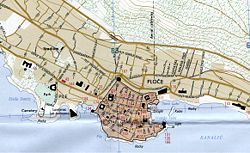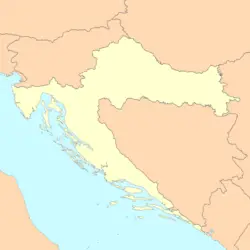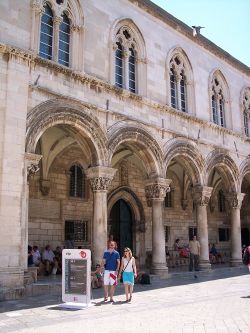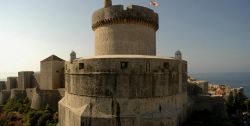Dubrovnik
| ||||||||||||||||||||||||||||||||||||||||||||
File:Old City, Dubrovnik.jpg Rooftops in Dubrovnik's Old City, a UNESCO World Heritage Site. | ||||||||||||||||||||||||||||||||||||||||||||
 Dubrovnik bridge of Franjo Tuđman and the Port of Gruž | ||||||||||||||||||||||||||||||||||||||||||||
Dubrovnik (IPA: [ˈdǔ.bro̞ːʋ.niːk]; Dalmatian: Ragusa; Latin: Ragusium, also Rhausium, Rhaugia; Italian: Ragusa) is a city on the Adriatic Sea coast in the extreme south of Croatia. Regarded as the most picturesque city on the Dalmatian coast, it is one of the most prominent tourist destinations on the Adriatic, a seaport and the centre of Dubrovnik-Neretva county.
In 1979, the city of Dubrovnik joined the UNESCO list of World Heritage Sites.
The prosperity of the city of Dubrovnik has always been based on maritime trade. In the Middle Ages, as the Republic of Ragusa, it became the only eastern Adriatic city-state to rival Venice. Supported by its wealth and skilled diplomacy, the city achieved a remarkable level of development, particularly during the 15th and 16th centuries. Ragusa was one of the centres of the development of primarily the Croatian language and literature, home to many notable poets, playwrights, painters, mathematicians, physicists and other scholars.
Geography
The Slavic toponym Dubrovnik originates from the Proto-Slavic term for an oak forest *dǫbrava or *dǫbrova (dubrava in archaic and literary Croatian), which was abundantly present in the hills north of the walled city of Dubrovnik by the end of the 11th century. The current name was officially adopted in 1909, when the city was under Austro-Hungarian rule.
Positioned at the terminal end of the Isthmus of Dubrovnik, the city is located on a promontory jutting into the sea under the bare limestone Mount Srdj.
The Dubrovnik Region has a typical Mediterranean climate, with mild, rainy winters and hot and dry summers. However, the Bora wind blows uncomfortably cold gusts down the Adriatic coast between October and April, and thundery conditions are common all the year round. In July, daytime maximum temperatures reach 84°F (29°C), and in January drop to 54°F (12°C). Mean annual precipitation is 51 inches (1298mm).
Rivers and canals Size – land area, size comparison Environmental issues Districts
History
Roman refugees fleeing the Slav and Avar sack of the nearby city of Epidaurus, today's Cavtat, founded Ragusa (Raugia) about 614 C.E. on a rocky island named Laus. Some time later a settlement of Slavic people grew at the foot of the forested Srđ hill. This settlement gives to the city its Slavic name "Dubrovnik". From that time, Dubrovnik was under Byzantine Empire protection.
The strip of wetland between Ragusa and Dubrava was reclaimed in the 12th century, unifying the city around the newly-made plaza (today Placa or Stradun). After the Crusades, Ragusa/Dubrovnik came under the sovereignty of Venice (1205–1358).
As a port located on overland trade routes to Byzantium and the Danube region, trade flourished. The Republic of Ragusa adopted Statutes, as early as 1272, which codified Roman practice and local customs, and provided for town planning. Between the 14th century and 1808, Ragusa ruled itself as a free state. A medical service was introduced in 1301, the first pharmacy (still working) was opened in 1317, and a refuge for old people was opened in 1347.
By the Peace Treaty of Zadar in 1358, Ragusa became part of the Hungaro-Croatian reign. The city’s first quarantine hospital (Lazarete) was opened in 1377, slave trading was abolished in 1418, the orphanage was opened in 1432 , and the water supply system (20 kilometers) was constructed in 1436.
The city was ruled by aristocracy that formed two city councils. As usual for the time, they maintained a strict system of social classes. The republic abolished the slave trade early in the 15th century and valued liberty highly. The city successfully balanced its sovereignty between the interests of Venice and the Ottoman Empire for centuries.
The economic wealth of the Republic was partially the result of the land it developed, but especially of the seafaring trade it did. With the help of skilled diplomacy, Ragusa's merchants traveled lands freely, and on the sea the city had a huge fleet of merchant ships (argosy) that traveled all over the world. From these travels they founded some settlements, from India to America, and brought parts of their culture and vegetation home with them. One of the keys to success was not conquering, but trading and sailing under a white flag with the word freedom (Latin: Libertas) prominently featured on it. That flag was adopted when slave trading was abolished in 1418.
The Republic gradually declined after a crisis of Mediterranean shipping — and especially a catastrophic earthquake in 1667 that killed over 5000 citizens, including the Rector, leveling most of the public buildings — ruined the well-being of the Republic. In 1699 the Republic sold two patches of its territory to the Ottomans to avoid terrestrial borderline, with advancing Venetian forces. Today this strip of land belongs to Bosnia and Herzegovina and is its only direct access to the Adriatic.
In 1806, the city surrendered to French forces, as that was the only way to cut a month's long siege by the Russian-Montenegrin fleets (during which 3000 cannonballs fell on the city). In 1808, Marshal Marmont abolished the republic and integrated its territory into the Illyrian provinces.
When the Habsburg Empire gained these provinces after the 1815 Congress of Vienna, the new imperial authorities installed a bureaucratic administration, which retained the essential framework of the Italian-speaking system. In 1815, the former Ragusan Government, i.e. its noble assembly, met for the last time in the ljetnikovac in Mokošica.
In 1848, the Croatian Assembly (Sabor) published People's Requests in which they requested among other things abolition of serfdom and the unification of Dalmatia with rest of Croatian lands (primarily with Austro-Hungarian Kingdom of Croatia). Dubrovnik municipality was the most outspoken of all Dalmatian communes in its support for unification with Croatia.
With fall of Austria-Hungary in 1918 after World War I, the city was incorporated into the new Kingdom of Serbs, Croats, and Slovenes (later the Kingdom of Yugoslavia). The name of the city was officially changed from Ragusa to Dubrovnik.
In World War II (1939-1945), Dubrovnik became part of the Nazi puppet Independent State of Croatia, occupied by an Italian army first, and by a German army after September 1943. In October 1944 Tito's partisans entered Dubrovnik, that became consequently part of Communist Yugoslavia. Soon after their arrival into the city, Partisans sentenced approximately 78 citizens to death without trial, including a Catholic priest.
In 1991 Croatia and Slovenia, which at that time were republics within Socialist Federal Republic of Yugoslavia, declared their independence. At that event, Socialist Republic of Croatia was renamed Republic of Croatia.
On October 1, 1991 Dubrovnik was attacked by JNA with a siege of Dubrovnik that lasted for seven months. Heaviest artillery attack happened on December 6 with 19 people killed and 60 wounded. Total casualties in the conflict according to Croatian Red Cross were 114 killed civilians, among them celebrated poet Milan Milisić. In May 1992 the Croatian Army liberated Dubrovnik and its surroundings, but the danger of sudden attacks by the JNA lasted for another three years. General Pavle Strugar, who was coordinating the attack on the city, was sentenced to an eight year prison term by the International Criminal Tribunal for the former Yugoslavia for his role in the attack of the city.
The 1996 Croatia USAF CT-43 crash killed everyone on a United States Air Force jet with VIP passengers.
Government
Croatia is a parliamentary democracy in which the president is chief of state, and is elected by popular vote for a five-year term (eligible for a second term). The prime minister is head of government, who, as leader of the majority party, is appointed by the president and approved by the Assembly. The unicameral Assembly, or Sabor, comprises 153 members elected from party lists by popular vote to serve four-year terms.
Dubrovnik is the administrative center of Dubrovnik-Neretva county, which is one of Croatia's 20 counties (županijas). Dubrovnik-Neretva county is divided into five cities and 17 municipalities. The county assembly comprises 41 representatives, and was presided over by Nikola Obuljen in 2008. Counties are regional self-government units with limted responsibility for education, health service, area and urban planning, economic development, traffic and traffic infrastructure and the development of network of educational, health, social and cultural institutions.
Municipalities and towns are local self-government units responsible for housing, area and urban planning, public utilities, child care, social welfare, primary health services, education and elementary schools, culture, physical education and sports, customer protection, protection and improvement of the environment, fire protection and civil defence.
Economy
Once one of the wealthiest of the Yugoslav republics, Croatia's economy suffered during the 1991-95 war as output collapsed and the country missed the early waves of investment in Central and Eastern Europe that followed the fall of the Berlin Wall. Since 2000, Croatia's economic fortunes have begun to improve, led by a rebound in tourism and credit-driven consumer spending. A high unemployment rate, a growing trade deficit, and uneven regional development pose challenges.
Per capita GDP, rank Financial and business services sector Tourism Manufacturing Transport: Road, rail, air, sea
Dubrovnik has an international airport of its own. The airport is located approximately 20 km (12 mi) from Dubrovnik city center, near Ćilipi. Buses connect the airport with the Dubrovnik bus station. In addition, a network of modern, local buses connects all Dubrovnik neighborhoods running frequently from dawn to midnight.
The A1 highway, in use between Zagreb and Šestanovac, is planned to be extended all the way to Dubrovnik. The highway will cross the, currently in construction, Pelješac Bridge. An alternative plan proposes the highway running from Neum through Bosnia and Herzegovina and an expressway continuing to Dubrovnik. This plan has fallen out of favor, though.
Demographics
Its population was 43,770 in 2001[1] down from 49,728 in 1991.[2]
In the 2001 census, 88.39% of its citizens declared themselves as Croats.
Languages spoken include Croatian 96.1 percent, Serbian 1 percent, other and undesignated 2.9 percent (including Italian, Hungarian, Czech, Slovak, and German).
The 2001 census shows that Roman Catholics make up 87.8 percent of the population, Orthodox 4.4 percent, other Christian 0.4 percent, Muslim 1.3 percent, other and unspecified 0.9 percent, none 5.2 percent.
Dubrovnik has a number of educational institutions. These include the University of Dubrovnik, a Nautical College, a Tourist College, a University Centre for Postgraduate Studies of the University of Zagreb, American College of Management and Technology, and an Institute of History of the Croatian Academy of Sciences and Arts.
Of interest
| Old City of Dubrovnik* | |
|---|---|
| UNESCO World Heritage Site | |
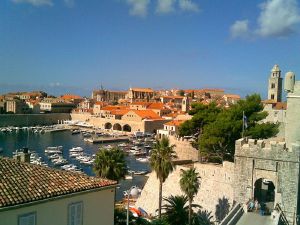
| |
| State Party | |
| Type | Cultural |
| Criteria | i, iii, iv |
| Reference | 95 |
| Region** | Europe and North America |
| Inscription history | |
| Inscription | 1979 (3rd Session) |
| Extensions | 1994 |
| Endangered | 1991-1998 |
| * Name as inscribed on World Heritage List. ** Region as classified by UNESCO. | |
The annual Dubrovnik Summer Festival is a cultural event when keys of the city are given to artists who entertain Dubrovnik's population and their guests for entire month with live plays, concerts, and games.
Ivan Gundulić, a 17th century Croatian writer, predicted the downfall of the great Turkish Empire in his great poem Osman. He wrote these immortal verses that are performed on every opening of the world famous Dubrovnik Summer Festival:
O, beautiful liberty, dear and sweet,
Thou heavenly gift where riches all meet,
Actual source of our glory of these hours,
The sole adornment of this grove of ours,
All silver, all gold, and our lives so dear,
Cannot recompense thy beauty so clear.
With these verses Dubrovnik major invites actors and poems to enter through main gates inside city stone walls. As a young actor Goran Višnjić played Hamlet at the Dubrovnik Summer Festival. He was noticed and approved by the public at the very start of his career. The Dubrovnik Summer Festival has been awarded its first Gold International Trophy for Quality (2007) by the Editorial Office in collaboration with the Trade Leaders Club.
February 3 is the feast of Sveti Vlaho (Saint Blaise), who is the city's patron saint. Every year the city of Dubrovnik celebrates the holiday with Mass, parades, and festivities that last for several days.[3]
Dubrovnik and its surroundings with numerous islands have a lot to offer in touristic activities for younger generations. Also popular are climbing on steep hills, hiking through the Mediterranean nature, and swimming in the clean, transparent sea.
New historical discoveries say that the usual misconception of Dubrovnik coming to be as joining of Laus island and Slav settlement of Dubrovnik is disputed by the fact that there was no island of Laus, only a peninsula, and it seems that there was a port on its location dating back to ancient history (thought to be the lost port of Heraclea).[citation needed]
The patron saint of the city is Sveti Vlaho (Saint Blaise), whose statues are seen around the city. He has an importance similar to that of St. Mark the Evangelist to Venice. The city's cathedral is named after Saint Blaise. The city boasts of many old buildings, such as the Arboretum Trsteno, the oldest arboretum in the world, dating back to before 1492. Also, the third oldest European pharmacy is located in the city, which dates back to 1317 (and is the only one still in operation today). It is located at Little Brothers church in Dubrovnik.[4]
In history, many Conversos (Marranos) were attracted to Dubrovnik, formerly a considerable seaport. In May, 1544, a ship landed there filled exclusively with Portuguese refugees, as Balthasar de Faria reported to King John. Another admirer of Dubrovnik, George Bernard Shaw, visited the city in 1929 and said: "If you want to see heaven on earth, come to Dubrovnik." This sentence is commonly used by tourist guides to describe the city.
In the bay of Dubrovnik is the 72-hectare wooded island of Lokrum, where according to legend, Richard the Lionheart was cast ashore after being shipwrecked in 1192. The island includes a fortress, botanical garden, monastery and naturist beach.
Dubrovnik has also been mentioned in popular film and theater. In the film 20,000 Leagues Under the Sea with Michael Caine, one of the characters said to have been dreaming of fairy from Dubrovnik (motive known from local legends and literature). In the film Rosemary's Baby, Roman Castevet, the leader of the witch coven, is falsely said to be in Dubrovnik, leading Rosemary to exclaim on his presence, "You're in Dubrovnik, I can't hear you." The 12th season of The Amazing Race, the remaining contestants went to the city of Dubrovnik.
Important monuments
Few of Dubrovnik's Renaissance buildings survived the earthquake of 1667 but fortunately enough remain to give an idea of the city's architectural heritage. [citation needed] The finest Renaissance highlight is the Sponza Palace which dates from the 16th century and is currently used to house the National Archives. The Rectors Palace is a Gothic-Renaissance structure that displays finely-carved capitals and an ornate staircase. It now houses a museum. The St Saviour Church is another fine remnant of the Renaissance period, next to the much-visited Franciscan Monastery. Over the entrance is a sculpture of the Pieta that dates from the late-Gothic period but the best part of the monastery is the Cloister with a colonnade of octagonal columns.
Dubrovnik's most beloved church is St Blaise's church, built in the 18th century in honor of Dubrovnik's patron saint. Dubrovnik's baroque Cathedral was built in the 18th century and houses an impressive Treasury with relics of Saint Blaise. The city's Dominican Monastery resembles a fortress on the outside but the interior contains an art museum and a Gothic-Romanesque church. [citation needed]
A striking feature of Dubrovnik is its walls that run 2km around the city. The walls run from four to six metres thick on the landward side but are much thinner on the seaward side. The system of turrets and towers were intended to protect the vulnerable city but now make one of the most picturesque sights in the Adriatic.[5]
Images
Panorama
Gallery
- Orlando, Dubrovnik, Croatia.JPG
The Orlando statue, symbol of a free city
- Dubrovnik walls.JPG
Dubrovnik as seen from its wall
ReferencesISBN links support NWE through referral fees
- ↑ City of Dubrovnik. Dubrovnik.hr. Accessed on July 2, 2007
- ↑ Dubrovnik. History.com Encyclopedia. Accessed on July 2, 2007
- ↑ Dubrovnik news
- ↑ Dubrovnik Online, monuments in Dubrovnik
- ↑ Croatia Traveller, Dubrovnik
Further reading
- Dubrovnik. 2007. Everyman mapguides. London: Everyman. ISBN 9781841592626
- Dubrovnik. 2006. Insight pocket guide. Singapore: APA.ISBN 9789812583222
- Carter, Francis W. 1972. Dubrovnik (Ragusa): a classic city-state. London: Seminar Press. ISBN 9780128129500
- Harris, Robin. 2003. Dubrovnik: a history. London: Saqi. ISBN 9780863563324
- Kremenjas-Danicic, Adriana. 2006. Roland's European Paths. Dubrovnik: Europski dom Dubrovnik. ISBN 953-95338-0-5
- McKelvie, Robin, and Jenny McKelvie. 2006. Dubrovnik & the Dalmatian coast. DK eyewitness top 10 travel guides. London: DK. ISBN 9780756615536
- Stuard, Susan Mosher. 1992. A state of deference: Ragusa/Dubrovnik in the medieval centuries. Middle Ages series. Philadelphia: University of Pennsylvania Press. ISBN 9780812231786
External links
- Encyclopaedia Britannica Dubrovnik Retrieved September 17, 2008.
- World Fact Book 2008 Croatia Retrieved September 17, 2008.
- Dubrovnik, Croatia BBC World Weather, retrieved September 17, 2008.
- Old City of Dubrovnik UNESCO World Heritage Center, retrieved September 19, 2008.
- Dubrovnik picture gallery Croatia-official.com, retrieved September 19, 2008.
- Dubrovnik Map - A Free Satellite image of Dubrovnik with pins on all important tourist locations.
Credits
New World Encyclopedia writers and editors rewrote and completed the Wikipedia article in accordance with New World Encyclopedia standards. This article abides by terms of the Creative Commons CC-by-sa 3.0 License (CC-by-sa), which may be used and disseminated with proper attribution. Credit is due under the terms of this license that can reference both the New World Encyclopedia contributors and the selfless volunteer contributors of the Wikimedia Foundation. To cite this article click here for a list of acceptable citing formats.The history of earlier contributions by wikipedians is accessible to researchers here:
The history of this article since it was imported to New World Encyclopedia:
Note: Some restrictions may apply to use of individual images which are separately licensed.

